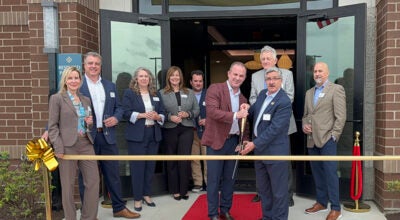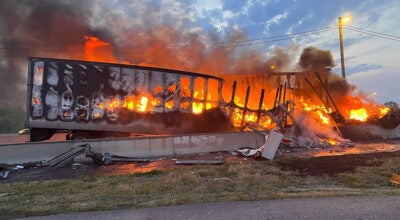Suffolk couple recovering
Published 8:45 pm Tuesday, March 31, 2020
|
Getting your Trinity Audio player ready...
|
Likely COVID-19 patients say they are on the mend
A Suffolk couple who likely had COVID-19 say they are on the mend after being sick this month.
The couple, who are both in their early 70s, agreed to speak with the Suffolk News-Herald on condition of complete anonymity while discussing their personal health details. Their doctor, Dr. Jeff Forman, chief medical officer for Bayview Physicians, agreed to speak on the record about the disease in general.
The couple have not actually been tested for COVID-19. As Forman explained, doctors are having to weigh the benefits of testing against potential risks. In a case like this, where there is an “overwhelming probability” they were positive based on symptoms and contact history, testing may not make any difference for the patient but will contribute to a testing backlog that could harm hospital patients and workers, he said.
The couple was interviewed by phone on Tuesday. The woman talked more than the man did, as he is still having some trouble talking.
She said they attended a church in Williamsburg on March 8. They’ve since learned that other people at the church, including two couples they were sitting very close to, have gotten sick and actually tested positive. The Peninsula Health District, which includes Williamsburg, has been very hard hit, with 136 cases as of this Tuesday.
“On the 10th, I got sick,” she said. “It started with coughing. I just couldn’t stop coughing and felt wiped out.”
She said her illness lasted about five to seven days. She sometimes felt like she might have a fever, although she didn’t take her temperature. She also had pain in her back, chest and abdomen, but she couldn’t tell whether it was body aches or just because she had coughed so much.
While she was still fighting the symptoms, he became sick on March 14.
“He has underlying asthma,” she explained. “That probably made things worse for him.”
The man was running fevers up to 101, she said. The couple treated the symptoms with Tylenol, and he was using his inhaler. They checked in with Dr. Forman by phone.
However, on March 23, they contacted Forman again to tell him that things weren’t changing for the man.
“On Wednesday, (my husband) started getting sicker,” she said. “(He) was short of breath.”
Dr. Forman delivered a pulse oximeter on Thursday last week, she said. The man’s oxygenation rate was only 91 — normal is in the high 90s.
The doctor ordered home health oxygen, but it didn’t arrive until Friday. Last Thursday night was rough. The man didn’t sleep a lot.
However, the oxygen made all the difference once it arrived, she said.
“He’s feeling lots, lots better,” she said.
He and she both remarked on the incredibly sudden onset of symptoms.
“It started so abruptly,” she said. “I can literally tell you about 4 o’clock in the afternoon that Tuesday, I started coughing my head off.”
The man said he would go even further than the hour.
“I could almost give the minute that the symptoms began, on that Saturday,” he said. “All at once, I felt very flushed, and started the coughing.”
They also remarked on how tired the disease made them feel.
“The malaise is really profound,” she said. “When I was the sickest, you just kind of slept all day. Eat breakfast, sleep all morning, maybe eat a little bit of lunch, sleep all afternoon and then you’d still sleep all night.”
The couple said they believe they are on the mend, now. She said she’s mostly back to normal.
“It seems like we’re definitely on the downside,” he added, although he’s still coughing a little. “No more fevers. My general strength and energy level is incrementally improving.”
While they have been recuperating, the couple has hunkered down and had their daughter deliver necessities to the doorstep.
“We are so grateful to Dr. Forman,” the woman said. “The oxygen really made all the difference. I think if we hadn’t had that, I would’ve had to take him to the ER.
“We were doing our best to try not to be in the hospital,” she added. “You don’t want to go take up a bed that someone else might really need, and we know the staff are working hard.”
Forman explained that it’s not just beds that hospitals are trying to conserve. The nationwide shortage of personal protective equipment for staff, such as masks and gowns, is a primary concern.
“People need to understand the risk and benefits of the approaches that we take,” Forman said. “We have limited ability to test, and we need quick turnaround testing for the people that are in the hospital, because we’re trying to conserve the personal protective equipment.”
He explained that if a hospital patient tests negative, that allows protective equipment that would have been used on them to be saved for positive COVID-19 patients.
Forman said patients who aren’t in the hospital and had a known contact usually don’t need to be tested if it won’t change the management of the disease.
He added it’s important for people to know that the vast majority of people will recover from the pandemic disease.
“If you get this, there’s a good chance that you will survive it,” he said. “There are very few people dying of this that don’t have some kind of significant underlying condition or they’re above 75 years of age. But that’s not to minimize that it’s a significant problem. It’s ramping up.”
Forman added that the disease is having a variety of progressions in different patients. Some are completely asymptomatic; some have milder, flu-like symptoms; some have more shortness of breath and fight it for longer; and some have a rapid and severe decline — from completely normal to intensive care in 24 or 48 hours.
The fact that most people will recover, however, doesn’t mean there isn’t a need for social distancing, Forman said.
“Our goal in health care is to keep the social distancing in effect,” he said. “We’re trying to stretch it out, so we can handle the number of patients coming. We do want to take it seriously; we do want to limit the exposures. We really do want to bend the curve and minimize the peak within our community so that Sentara Obici Hospital can manage the surge in patients and we can do it in a safe manner.”






